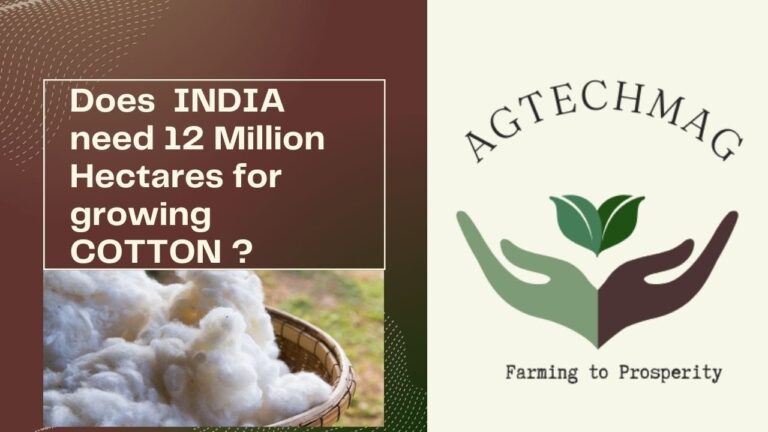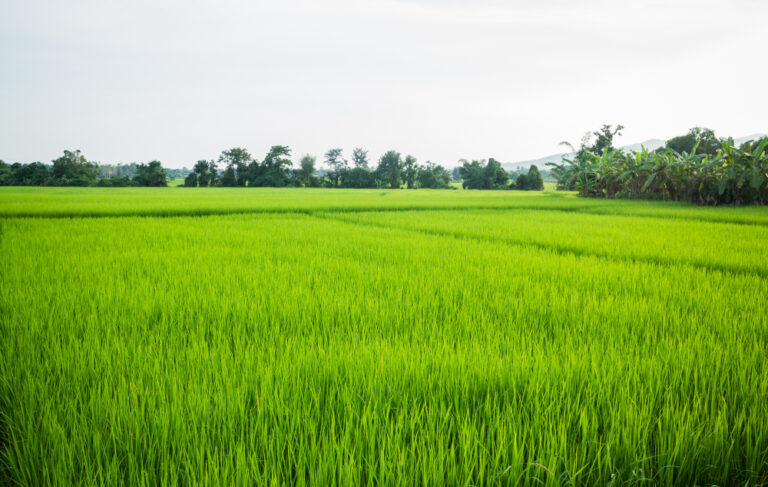Sugarcane is an important commercial crop contributing significantly to the World economy. It not only contributes to food production, but also is an important source of “Bioenergy” used in the form of fuel and electricity. It also generates valuable biproducts which can be used as source of plant and animal nutrition.
Sugarcane is a plant with C4 metabolism which enables higher photosynthetic efficiency (eg: other C4 crops are Maize and Sorghum) compared to plants with C3 metabolism (Eg: other C3 plants are Rice, Wheat, etc.). Also, Sugarcane is a long duration crop ranging from 12-18 months period grown both in tropical and sub-tropical regions. In India
Rethink Sugarcane: A Crop of Sweet Solutions, Not a Water Guzzler”
Sugarcane is grown in 4.5 to 5.8 million ha majorly in 12-13 States of the country.
The yield of Sugarcane ranges from 60 tons per ha to 100 tons per ha, which is subject to agro-climatic conditions, ratooning, choice of plant variety, availability of irrigation, management practices, soil health, etc. Cane yields produced under rainfed conditions can vary greatly. Good yields in the humid tropics of a totally rainfed crop can be in the range of 70 to 100 ton/ha cane, and in the dry tropics and subtropics with irrigation, 110 to 150 ton/ha cane. The average productivity of Sugarcane in India is 84tons/ha which has increased by 20% in the past two decades. States of Tamilnadu, Karnataka and Maharashtra have higher productivity of >90 tons per ha.
Sugarcane is a water-intensive crop and adequate moisture should be available during the growing period for obtaining maximum yields, as cane growth is directly proportional to the water transpired by the plant. Depending on agro-climatic conditions, water requirement of sugarcane ranges from 1500 to 2500 mm, to be available as evenly distributed over the entire growing season (Establishment phase, Vegetative phase, Cane development (Yield formation) phase and Cane maturity (Ripening) phase). Water use efficiency is generally measured as the overall effectiveness of water (rainfall and irrigation) for cane yield per unit of crop water use.
Irrigation water requirement
It has been estimated that the irrigation water requirement for sugarcane crop in India, ranges between 37.5 cm (Bihar) to 297 cm (TamilNadu) or about 5 – 40 irrigations of 7.5 cm each per hectare during its crop growth, as per a study undertaken by CACP. On an average sugarcane requires 1500- 2000 mm of water / year to produce 100 tonnes of millable cane (150-200 lakh litre/ annum/ ha in full season). This translates to an average of about 88 kg water/ kg of cane and 884 kg of water/ kg of sugar for a fresh planted crop, and about 118 kg water/ kg of cane or 1157 kg water/ kg of sugar for a ratoon crop, calculated as Physical Water Productivity (PWP), but with wide variations among states and regions.
Generally, states in the northern sub-tropical region have higher rainfall, cooler winters and shorter growing season and thus lower irrigation water requirements. Therefore, the Irrigation Water Productivity (IWP) is high in the states of Bihar, Uttar Pradesh, and Uttarakhand, i.e., each unit of applied irrigation water in these states produce more output as compared to the tropical region states of Andhra Pradesh, Karnataka, Maharashtra and Tamil Nadu. Each unit of applied irrigation water in the water-stressed states of Maharashtra, Tamil Nadu, Andhra Pradesh, and Karnataka is only about one-third of the IWP in Bihar and Uttar Pradesh. The number of irrigations in Sugarcane crop, as published by Directorate of Sugarcane Development is given below, which provides the variability of water consumption in line with the agro-climatic region.
As per the NITI-AAYOG Taskforce report on Sugarcane and Sugar industry, 1500-2500 litres of water is used for production of 1 kg sugar. The report cites CACP study and recommends that there is a stark difference between irrigation water usage in South India and Maharashtra and Northern Sugarcane growing states. Implementation of drip irrigation in Southern states and Maharashtra can reduce water consumption by 40%-50%.
In line with the above, water consumption needs to be assessed and interpreted in various dimensions including, Physical Water Productivity (PWP), Irrigation Water Productivity (IWP) and Water Footprint (WF). Interpretation of Consumptive Use of Water and PWP in isolation, at times may provide incomplete and misleading information, which may further lead to ineffective policy and fragmented understanding of the economic scenarios. Therefore, a holistic approach and framework methodology is required for assessment of Water consumption including consideration of IWP, WF and ecological footprint for sustainable development.
A multi-dimensional tool to quantify the amounts of freshwater needed to produce goods and services and to assess the impact on water scarcity is the water footprint (WF) concept. The tool defines three WFs, viz., the green WF referring to the rainwater consumed, the blue WF refers to surface and groundwater volumes consumed (evaporated or incorporated into the product) and the grey WF of a product refers to the volume of freshwater required to assimilate the load of pollutants based on existing ambient water quality standards.
The WF model has been used as holistic framework by international organizations such as UN, FAO, IEA, etc., and national level agencies such as NITI-AAYOG ICAR, SAUs, etc. Several studies have been conducted in the past decade on bioenergy and feedstock crops such as Sugarcane to study the WF, which have shown that Sugarcane has been one of the most efficient for biomass assimilation and conversion amongst various crops with a lower WF. Further with appropriate interventions such as better Plant varieties, improvements in agronomy and irrigation systems, the overall ecological footprint including WF, Land Footprint (LF) and Carbon Footprint (CF) can be significantly improved for effectively aligning with sustainable development goals.
Among the early studies on WF, Water Footprints of various crops were assessed and it was found that WF of Sugarcane is found significantly lower than food crops like Rice, Wheat, Maize and Soybean As per another study which assessed 12 crops producing Bio-energy, it was found that For bioethanol generation, sugar beet, and sugar cane are the most favourable crops. In a study to assess first generation Bioenergy crops, it was found that Sugarbeet, Sugarcane and Potato were the top three in terms of WF.
In a comprehensive study on LF,CF and WF in circular bio-energy production systems it was found that Sugarcane is the most efficient feedstock for producing net bioethanol, bioelectricity and Combined Heat and Power (CHP) per unit area while sugar beet comes second. Maize gives the least bioethanol per unit area, four times less than either sugar beet or sugarcane in net terms. The study concluded that Among the five feedstock crops, sugar beet and sugarcane require the least water and land resources per unit of bioelectricity and biofuel energy output while also emitting the least amount of Green House Gases (GHGs).
As per the detailed technical bulletin of Indian Institute of Sugarcane Research (ICAR-IISR), provides for various agronomic practices for reducing the WFP of the crop. Further it concludes that Sugarcane has a productivity of Rs 11.98 per every litre of water compared to Rs 9.70 for Wheat and Rs 5.40 per Rice. In a recent study undertaken by Sugarcane Breeding Institute (ICAR-SBI), Coimbatore . Water efficient Sugarcane hybrids with lower Green and Blue WFs were assessed with respect to impact of deficit irrigation scheduling, planting techniques and water conservation measures and genotypic evaluation under variable irrigation scheduling. The study concluded that WF in Sugarcane is influenced by Water conservation measures like trash mulching, choice of Sugarcane variety, agronomic practices and deficit irrigation scheduled through drip irrigation and water conservation practices.
Conclusion
In summary, holistic assessment and review of resource-use efficiency is essential for formulation of strategies and policies for productivity enhancement of Sugarcane and Sugar industry are essential. Water being an important and critical resource in Sugarcane both as a food and bioenergy crop, the crop water consumption in isolation provides only a limited inference and insights and often portrays Sugarcane as a Water-guzzler. While indeed, it is a water intensive crop, Sugarcane as a C4 plant also has a very high photosynthetic efficiency in terms of Biomass conversion. Further given the importance of climate change, the stress that a crop or economic or human activity towards Climate change also needs to be assessed.
The Water FootPrint (WF) approach being followed globally and nationally need to be considered while interpretation of resource use, more so, for food and bio-energy crops such as Sugarcane, Sugarbeet, Maize, Soybean, etc. This can provide a balanced view for interpretation of scientific results and also as a foundation for development of policy in line with Sustainable Development Goals.
References:
https://sugarcane.icar.gov.in/index.php/sugarcane-statistics/ 22
https://sugarcane.icar.gov.in/wp-content/uploads/2024/01/3_area.pdf 33
https://www.fao.org/land-water/databases-and-software/crop-information/sugarcane/fr/ 4 https://cacp.dacnet.nic.in/ViewReports.aspx?Input=2&PageId=41&KeyId=808 5
Click to access 636988050947079153_GlimpsesofSugarcaneCultivation_2020.pdf
Click to access 10_Report_of_the_Task_Force_on_Sugarcan_%20and_Sugar_Industry_0.pdf
https://www.pnas.org/doi/epdf/10.1073/pnas.1109936109 9
https://digitalcommons.unl.edu/cgi/viewcontent.cgi?article=1069&context=wffdocs 10
https://www.waterfootprint.org/resources/Report29-WaterFootprintBioenergy.pdf 11
https://ris.utwente.nl/ws/portalfiles/portal/5146564/Hoekstra09WaterFootprintManual.pdf 12 https://www.niti.gov.in/sites/default/files/2023-08/Report_on_Water_Neutrality_Framework_WR%26LR_vertical.pdf 13
https://iisr.icar.gov.in/iisr/download/publications/report/waterfootprintinsugarcane.pdf 14 https://tools.waterfootprint.org/product-gallery/#:~:text=Cane%20sugar%20has%20generally%20a,is%20attributed%20to%20by%2Dproducts. 15
https://waterfootprint.org/resources/Mekonnen-Hoekstra-2011-WaterFootprintCrops.pdf 1616




